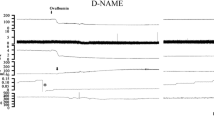Abstract
Leukotriene B4 (LTB4), a metabolite of arachidonic acid, is known to be a potent chemotactic and chemokinetic substance. We have used the hamster cheek pouch microcirculation model to study the effect of LTB4 on vascular permeability and the involvement of neutrophil granulocytes in this response. Intravascular fluorescein-labeled dextran (mol wt 150,000) was used as a tracer of macromolecular permeability. Topical application of LTB4 (150 nM-5 μM) to the hamster cheek pouch resulted in an immediate increase in adhering leukocytes in postcapillary venules and later larger venules. Leukocyte accumulation was reversible, but continued longer the higher the dose of LTB4 used. Subsequently, a dose-dependent increase in vascular permeability was seen at postcapillary and larger venules, with a maximum 10–20 min after application; the maximum occurred later the higher the dose of LTB4. Depletion of neutrophil granulocytes by pretreatment of the animals with antineutrophil serum obtained from immunized rabbits significantly decreased the permeability response to LTB4, whereas the response to histamine was unaffected. These results suggest that neutrophil granulocytes play a role in LTB4-mediated permeability increase. LTB4 may be of importance both for the leukocyte accumulation and for the edema formation seen in inflammatory reactions.
Similar content being viewed by others
References
Borgeat, P., andB. Samuelsson. 1979. Arachidonic acid metabolism in polymorphonuclear leukocytes: Effect of ionophore A23187.Proc. Natl. Acad. Sci. U.S.A. 76:2148–2152.
Doig, M. V., andA. W. Ford-Hutchinson. 1980. The production and characterization of products of lipoxygenase enzyme systems released by rat peritoneal macrophages. Prostaglandins20:1004–1019.
Ford-Hutchinson, A. W., M. A. Bray, M. V. Doig, M. E. Shipley, andM. J. H. Smith. 1980. Leukotriene B, a potent chemokinetic and aggregating substance released from polymorphonuclear leukocytes.Nature 286:264–265.
Goetzl, E. J., andW. C. Pickett. 1980. The human PMN leukocyte chemotactic activity of complex hydroxy-eicosatetraenoic acids (HETEs).J. Immunol. 125:1789–1791.
Palmer, R. M. J., R. J. Stepney, G. A. Higgs, andK. E. Eakins. 1980. Chemokinetic activity of arachidonic acid lipoxygenase products on leucocytes of different species.Prostaglandins 20:411–418.
Malmsten, C. L., J. Palmblad, A.-M. UdÉn, O. Rådmark, L. Engstedt, andB. Samuel-Sson. 1980. Leukotriene B4: A highly potent and stereospecific factor stimulating migration of polymorphonuclear leukocytes.Acta Physiol. Scand. 110:449–451.
Smith, M. J. H., A. W. Ford-Hutchinson, andM. A. Bray. 1980. Leukotriene B: A potent mediator of inflammation.J. Pharm. Pharmacol. 32:517–518.
Björk, J., K.-E. Arfors, P. Hedqvist, S.-E. DahlÉn, J.-Å. Lindgren. 1982. Leukotriene B4 causes leukocyte migrationin vivo. European J Pharmacol.4 (Submitted).
Wedmore, C. V., andT. J. Williams. 1981. Control of vascular permeability by polymorphonuclear leukocytes in inflammation.Nature 289:646–650.
Bray, M. A., F. M. Cunningham, A. W. Ford-Hutchinson, andM. J. H. Smith. 1981. Leukotriene4: A mediator of vascular permeability.Br. J. Pharmacol. 72:483–486.
Simpson, D. M., andR. Ross. 1971. Effects of heterologous antineutrophil serum in guinea pigs. Hematologic and ultrastructural observations.Am. J. Pathol. 65:79–102.
Karlsson, K.-A., andE. Thal. 1974. Studies on the detection of salmonellae in fishmeal by the direct and indirect immunofluorescent method.Nord. Vet. Med. 26:492–498.
Duling, B. R. 1973. The preparation and use of the hamster cheek pouch for studies of the microcirculation.Microvasc. Res. 5:423–429.
Svensjö, E., K.-E. Arfors, G. Arturson, andG. Rutili. 1978. The hamster cheek pouch preparation as a model for studies of macromolecular permeability of the microvasculature.Upsala J. Med. Sci. 83:71–79.
Svensjö, E., C. G. A. Persson, andG. Rutili. 1977. Inhibition of bradykinin induced macromolecular leakage from postcapillary venules by β2-adrenoreceptor stimulant, terbutaline.Acta Physiol, Scand. 101:504–506.
Del Maestro, R. F., J. Björk, andK.-E. Arfors. 1981. Increase in microvascular permeability induced by enzymatically generated free radicals. Part I. In vivo study.Microvasc. Res. 22:239–254.
Dahlén, S.-E., J. Björk, P. Hedqvist, K.-E. Arfors, S. Hammarström, J.-Å. Lindgren, andB. Samuelsson. 1981. Leukotrienes promote plasma leakage and leukocyte adhesion in postcapillary venues: In vivo effects with relevance to the acute inflammatory response.Proc. Natl. Acad. Sci. U.S.A. 78:3887–3891.
Ley, K., and K.-E.Arfors. 1982. Changes in macromolecular permeability by intravascular generation of oxygen derived free radicals.Microvasc. Res. (in press).
Issekutz, A. C. 1981. Vascular responses during acute neutrophilic inflammation: Their relationship to in vivo neutrophil emigration.Lab. Invest. 45:435–441.
Joyner, W. L., E. SvensjÖ, andK.-E. Arfors. 1979. Simultaneous measurements of macomolecular leakage and arteriolar blood flow as altered by PGE1 and β2-receptor stimulant in the hamster cheek pouch.Microvasc. Res. 18:301–310.
Sacks, T., C. F., Moldow, P. R. Craddock, T. K. Bowers, andH. S. Jacob. 1978. Oxygen-radicals mediate endothelial cell damage by complement-stimulated granulocytes.J. Clin. Invest. 61:1161–1167.
Rae, S. A., andM. J. H. Smith. 1981. The stimulation of lysosomal enzyme secretion from human polymorphonuclear leukocytes by leukotriene B4.J. Pharm. Pharmacol. 33: 616–617.
Hafstrom, I., J. Palmblad, C. L. Malmsten, O. Rådmark, andB. Samuelsson. 1981. Leukotriene B4-a stereospecific stimulator for release of lysosomal enzymes from neutrophils.FEBS Lett. 130:146–148.
Author information
Authors and Affiliations
Rights and permissions
About this article
Cite this article
Björk, J., Hedqvist, P. & Arfors, KE. Increase in vascular permeability induced by leukotriene b4 and the role of polymorphonuclear leukocytes. Inflammation 6, 189–200 (1982). https://doi.org/10.1007/BF00916243
Issue Date:
DOI: https://doi.org/10.1007/BF00916243




